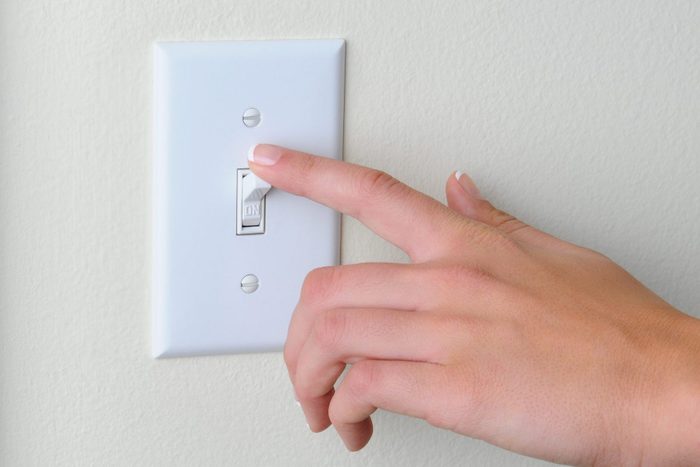Light Switch Not Working? Try This.

Light switches can't last forever with all the abuse they take. If one of yours stops working, here's what to try before calling in a pro.
Our editors and experts handpick every product we feature. We may earn a commission from your purchases.
Walking into a dark or unfamiliar room can be disorienting. Our hands instinctively go to the nearest wall, searching for a light switch. We snap it on, and instantly the room feels familiar again. Light provides safety and comfort while saving us from banging into coffee tables.
If you flip a switch and nothing happens, don’t panic. Here are a few things you can try before calling in an electrician.
Safety note: Switches act like a dam in a river: They either hold current back or allow it through. That means there’s always power running to the switch unless you shut off the power at the electrical panel. Always assume electricity is present at the switch, and proceed accordingly.
On This Page
Survey the Situation
Electricians love to say “work smarter, not harder,” and they’re great words to live by. Taking the time to assess your situation before barging in saves work, time and money.
Look around the room and take mental notes. What does the switch control? Are all the lights off in the room, or just one? Do other switches in the room control the same lights? Do those switches work? Do you smell anything or feel heat? (If you do, turn off the power right away.)
Once you’ve gotten a read on the situation, start with the basics:
Check the Light
If only one light’s out, try the bulb. Tighten it if it’s loose. If that doesn’t solve the problem, unscrew it and try it in a working fixture. If the bulb is fine or the whole room is out, it’s likely a wiring or switch problem.
Check the GFCI
In commercial construction, lights and receptacles often run on different voltages and thus use separate circuits. But in residential buildings, particularly older homes, everything in a room may be on the same circuit.
If you have a GFCI receptacle in the room where the switch isn’t working, check to see if it tripped. If so, reset it.
Check the Breaker
Next, check to see if the breaker tripped. Carefully open your electrical panel door. Most of the circuit breakers will be on, so look for one in a different position than the rest. The breaker handle will be in the middle, between On and Off.
If your panel has an updated directory on the front cover, verify the tripped circuit against the label and update the directory if needed. This small step will help the next person working in the panel — possibly you.
Stand to the side and flip the tripped breaker to Off, then to On. If resetting the breaker doesn’t solve the problem, turn your focus to the switch.
Turn Off the Power
Before troubleshooting a switch, turn off the breaker controlling the circuit. Secure the breaker with a lockout to prevent another person from turning on the circuit.
Ensure Power is Off
Test your non-contact voltage tester on a known live circuit, like a wall receptacle with an appliance plugged in and On. The tester should beep and light up.
Remove the switch cover with a screwdriver, or pull off the faceplate if it’s the snap-in kind. Run your tester along the perimeter of the switch, checking every terminal on the switch. If the tester reacts, stop working until you find the correct circuit and shut off the power.
Check Connections
Carefully unscrew and pull the switch out of the wall by the mounting straps only. Test the terminals again, and push your tester into the box to find any unrelated live circuits. Turn off any additional circuits and verify they’re Off with the tester.
Check the connections on the switch. They should be snug, tight and wrapped clockwise around the screw terminals. (Avoid using stab-in connections on electrical devices, which tend to loosen over time and with movement.)
Tighten any loose screws and wrap the terminals with electrical tape. Close up the switch and turn on the breaker.
Test and/or Replace the Switch
If that didn’t work, and you don’t see loose wires or other problems like melted plastic, the switch itself might be bad. Switches last for years and thousands of throws, but occasionally they wear out.
Before removing the switch to test or replace, turn off the power again (and verify). Label the common (hot) wire and incoming and outgoing travelers with electrical tape, if applicable. Remove the switch completely from the wall.
Test
Electrical circuits must have a continuous path for current to flow. Testing the continuity of a switch will tell you if it impedes current flow when it shouldn’t. If you have a multimeter or continuity tester, test the switch before replacing.
Depending on the type of device you have, set the dial to “ohms” or “continuity” and apply the leads to the switch terminals to test. Follow the instructions on your tester to see if the switch is in good working order.
Replace
If the switch is bad, or you just want to swap it out without testing, replace it with a new switch of the same ampere rating and type — single-pole, three-way, etc. (This is where labeling the wires before removing the switch comes in handy.)
Switches aren’t expensive — less than a dollar for a single-pole snap switch — so if this doesn’t fix the problem, you won’t be out a lot of money.
If It’s Not the Switch…
If the switch still doesn’t control the lights after you’ve tested and replaced it, you may have a wiring issue at the light or elsewhere in your circuitry. Investigate further if you have the know-how, or call a licensed electrician.



